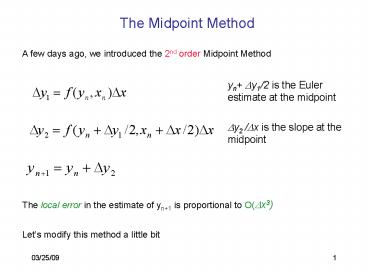The Midpoint Method - PowerPoint PPT Presentation
1 / 16
Title:
The Midpoint Method
Description:
Typically Adams-Moulton is used together with Adams-Bashforth as a Predictor-Corrector Method. Adams-Bashforth Predictor. Adams-Moulton Corrector ... – PowerPoint PPT presentation
Number of Views:540
Avg rating:3.0/5.0
Title: The Midpoint Method
1
The Midpoint Method
A few days ago, we introduced the 2nd order
Midpoint Method
The local error in the estimate of yn1 is
proportional to O(?x3)
Lets modify this method a little bit
2
Modified Midpoint Method
Advance the solution of an ODE from x to xH via
a sequence of n steps of length h H/n
First Step Explicit Euler
2nd to n-1st Step Midpoint Method
Last Step Combination of Midpoint and Euler
n1 function evaluations are needed
3
Modified Midpoint Method
The Modified Midpoint Method is useful for two
important reasons
1. It is second-order accurate even though only
n1 function evaluations are needed
2. It has an error series that can be expressed
in even powers of h
We can play our usual trick of combining steps
with different h-values to eliminate error terms
4
Modified Midpoint Method
Using two repeated crossings of the interval with
stepsizes h and h/2
We can eliminate the h2-term
5
Modified Midpoint Method
The estimate is fourth-order accurate, the same
as fourth-order Runge-Kutta
However Modified Midpoint requires about 1.5
evaluation per step Fourth-order Runge-Kutta
requires 4 evaluation per step
6
Remember Romberg Integration
For Romberg Integration we had tabulated the
results as
Only the first column requires an evaluation of
the function
We can use the same scheme here to extrapolate
the solution of our ODE to higher order accuracy
--gt Bulirsch-Stoer Method
7
Bulirsch-Stoer Method
The Bulirsch-Stoer Method is for differential
equations representing smooth functions.
A single Bulirsch-Stoer step takes us from x to
xH This step consists of of many substeps of the
modified midpoint method
Next the interval from x to xH is crossed in
separate attempts with an increasing number of n,
the number of substeps
After each successive n, we can calculate the
extrapolated value and an error estimate
8
Practical Consideration
n 2, 4, 6, 8, 10, 12, 14, 16, ., nj 2j,
Question How far do we push this scheme?
Remember Have some mistrust for extrapolation.
Typically If no acceptable solution is found
after 8 crossings of the interval STOP and
reduce the interval size H
There might be an obstacle in the way and we
should not extrapolate
Remember Bulirsch-Stoer is BEST for smooth
functions
9
Multistep Methods
In the previous methods (Runge-Kutta,
Bulirsch-Stoer), the value of yn1 at xn1
depended only on yn. These methods are called
Single-Step Methods
In a multistep method, we approximate f(x, y) by
a polynominal that passes through several
previous points (and possibly through xn1)
Solving an ODE can be compared to integrating
over the derivative f(x, y)
10
Multistep Methods
Common approach Construct yn1 from a sum of yn
and a weighted average of the fns
11
Adams-Bashforth Method
Lets consider the third-order Adams-Bashforth
scheme
Explicit Scheme
Our goal is to find the coefficients ai.
We have two possible approaches
1. Interpolate a second-order polynominal to f1,
f2, and f3
2. Integrate the ODE and solve the system of
equations for the ais.
Lets use the second method
12
Adams-Bashforth Method
Integrating the ODE (create its
anti-derivative)
Third-order Adams-Bashforth now means that
Using a quadratic interpolation polynominal
through fn to fn-2 --gt exact when f is any
polynominal of degree 2 or less!
13
Adams-Bashforth Method
Shift the origin to xxn
Lets use f 1, f x, and f x2
14
Adams-Bashforth Method
Our set of equations becomes
15
Adams-Moulton Corrector
Now that we have determined yn1 using the
Adams-Bashforth method, we can use it to estimate
f(xn1, yn1)
With this new information we can use the implicit
form of the multistep method
Using again just three points for the
interpolation
The coefficients can be obtained in the same
manner as before, using f 1, f x, and f
x2
They are
16
Adams-Moulton Corrector
Typically Adams-Moulton is used together with
Adams-Bashforth as a Predictor-Corrector Method
Adams-Bashforth Predictor
Adams-Moulton Corrector

